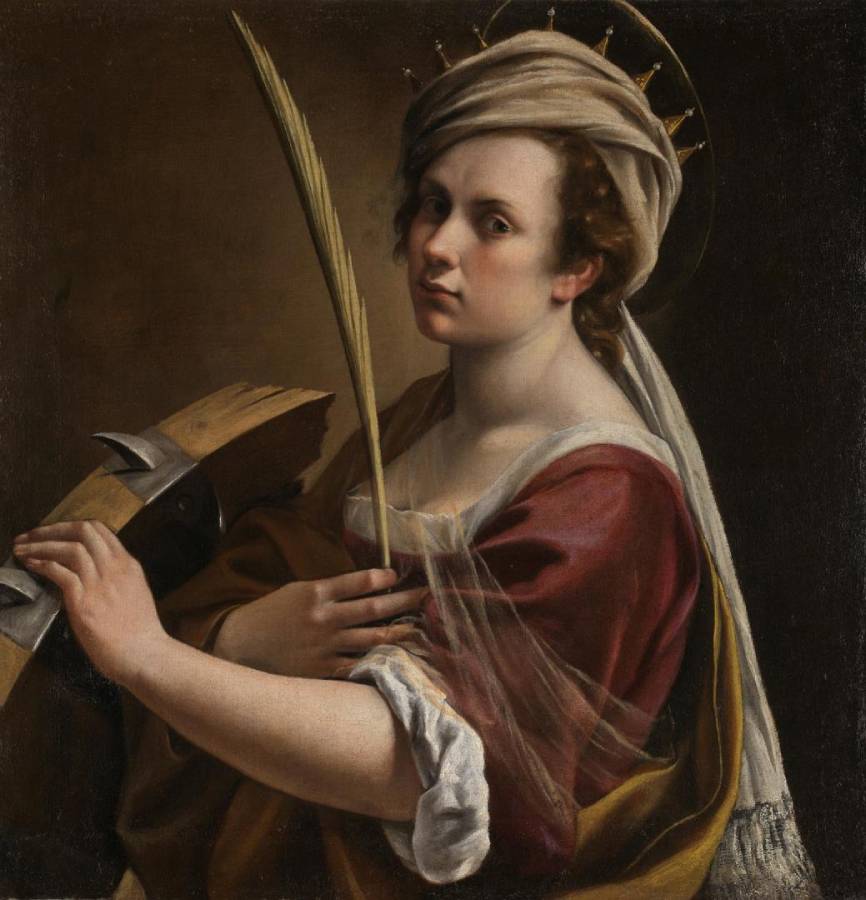Gentileschi, Artemisia (1593-c.1653)
Autoritratto come Santa Caterina d’Alessandria (Self Portrait as Saint Catherine of Alexandria)
c.1615–1617
Oil on canvas, 71.4 × 69 cm
National Gallery, London
Artemisia Gentileschi, the most celebrated female artist of the seventeenth century, appears in the guise of Saint Catherine of Alexandria, a Christian saint who died for her faith in the early fourth century. She leans on a broken wheel studded with iron spikes, on which she was bound and tortured, and which became her standard attribute in art. Her right hand, delicately holding a martyr’s palm between thumb and forefinger, is brought to her chest.
Artemisia was born in Rome, the only daughter of the artist Orazio Gentileschi, under whom she trained. At the age of 17 she was raped by Agostino Tassi, a family friend and Orazio’s artistic collaborator. During the infamous trial that followed, Artemisia testified and was tortured. After the trial she married and moved to Florence, where this painting was probably made. Saint Catherine’s facial features, the turn of her head and three-quarter pose, are all closely related to those in Artemisia’s Self Portrait as a Lute Player of about 1615–8 (Wadsworth Atheneum, Hartford, Connecticut).
Artemisia seems to have used her own image frequently in works she produced in Florence – a number of self-portraits are known and others are recorded in seventeenth century inventories. New to the city and keen to demonstrate her talent, she may have painted these pictures in a conscious act of self-promotion. Many of Artemisia’s paintings, in particular those depicting a strong female heroine, have often been read in biographical terms. Here, the choice of representing herself as a saint who underwent both psychological trials and physical torture may have been made by Artemisia or her patron, but nothing is known of the circumstances in which this painting was commissioned.
The tightly cropped composition of this picture focuses our attention on Saint Catherine’s resolute face and strong arm. The painting is contained in a tight square of approximately 70 cm and the saint is shown life-size and close up, against a plain background. She stands in the centre of the image, her head turned to gaze directly out at the viewer, while her body faces the wheel – the instrument of her torture. Only part of the wheel is visible and the close cropping adds to the intensity of the work, as does the theatrical lighting – a strong light from the right illuminates the claw-like spikes on the wheel, Catherine’s outstretched arm and the gleaming skin of her neck and shoulder. By contrast, the inside of the wheel and the folds of her dress are in deep shadow, the darkness to her right offsetting the light tones of her skin and turban. The painting’s naturalism and dramatic lighting are reminiscent of Caravaggio, who had associated with Artemisia’s father Orazio in the first decade of the seventeenth century and whose work had an enduring influence on her.
Like Orazio and Caravaggio, Artemisia was admired during her lifetime but was forgotten over the following centuries. Her work has only been properly re-evaluated over the last 50 years, and many paintings remain unidentified – her Self Portrait as Saint Catherine of Alexandria was only discovered in 2017, and acquired by the Gallery shortly afterwards. (NG)
Compare:
 Gentileschi, Artemisia (1593-c.1653)
Gentileschi, Artemisia (1593-c.1653)
Autoritratto come suonatrice di liuto
c.1615–1618
Wadsworth Atheneum, Hartford
